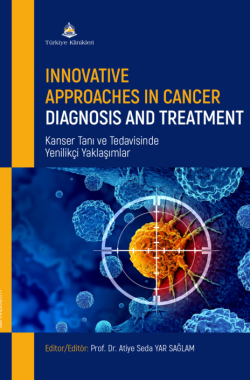Proteolysis-Targeting Chimeras and Cancer Therapy
Akın YILMAZa
aAmasya University Faculty of Medicine, Department of Medical Biology, Amasya, Türkiye
Yılmaz A. Proteolysis-targeting chimeras and cancer therapy. In: Yar Sağlam AS, ed. Innovative Approaches in Cancer Diagnosis and Treatment. 1st ed. Ankara: Türkiye Klinikleri; 2024. p.7-12.
ABSTRACT
Proteolysis Targeting Chimeras (PROTACs) have represented a significant advancement in drug discovery and targeted therapy. Through their ability to induce the degradation of specific target proteins via the Ubiquitin-Proteasome System (UPS) by inducing activity of a particular E3 ligase, PROTACs offer promising opportunities for the treatment of various diseases, including cancer. By leveraging the power of molecular targeting and exploiting the ubiquitin-proteasome pathway, PROTACs present a novel approach to modulating protein levels and function within cells. Furthermore, their potential to overcome drug resistance mechanisms and improved selectivity positions them as innovative therapeutic agents. With ongoing research in PROTAC technology, further discoveries and the translation of PROTAC-based therapies into clinical practice are anticipated, ultimately benefiting patients worldwide.
Keywords: Proteolysis-targeting chimera, PROTAC; ubiquitin-protein ligases; proteolysis; ubiquitinated proteins
Kaynak Göster
Referanslar
- Gharwan H, Groninger H. Kinase inhibitors and monoclonal antibodies in oncology: clinical implications. Nat Rev Clin Oncol. 2016;13(4):209-27. [Crossref] [PubMed]
- Wang P, Zhou J. Proteolysis Targeting Chimera (PROTAC): A paradigm-shifting approach in small molecule drug discovery. Curr Top Med Chem. 2018;18(16):1354-6. [Crossref] [PubMed]
- Wan Y, Yan C, Gao H, Liu T. Small-molecule PROTACs: novel agents for cancer therapy. Future Med Chem. 2020;12(10):915-38. [Crossref] [PubMed]
- Sakamoto KM, Kim KB, Kumagai A, Mercurio F, Crews CM, Deshaies RJ. Protacs: Chimeric molecules that target proteins to the Skp1-Cullin-F box complex for ubiquitination and degradation. Proc Natl Acad Sci U S A. 2001;98(15):8554-9. [Crossref] [PubMed] [PMC]
- Bard JAM, Goodall EA, Greene ER, Jonsson E, Dong KC, Martin A. Structure and function of the 26S proteasome. Annu Rev Biochem. 2018;87:697-724. [Crossref] [PubMed] [PMC]
- Hipp MS, Kasturi P, Hartl FU. The proteostasis network and its decline in ageing. Nat Rev Mol Cell Biol. 2019;20(7):421-35. [Crossref] [PubMed]
- Spano D, Catara G. Targeting the ubiquitin-proteasome system and recent advances in cancer therapy. Cells. 2024;13(1):29. [Crossref] [PubMed] [PMC]
- Yau R, Rape M. The increasing complexity of the ubiquitin code. Nat Cell Biol. 2016;18(6):579-86. [Crossref] [PubMed]
- Lai AC, Crews CM. Induced protein degradation: an emerging drug discovery paradigm. Nat Rev Drug Discov. 2017;16(2):101-14. [Crossref] [PubMed] [PMC]
- Békés M, Langley DR, Crews CM. PROTAC targeted protein degraders: the past is prologue. Nat Rev Drug Discov. 2022;21(3):181-200. [Crossref] [PubMed] [PMC]
- Nalawansha DA, Crews CM. PROTACs: An emerging therapeutic modality in precision medicine. Cell Chem Biol. 2020;27(8):998-1014. [Crossref] [PubMed] [PMC]
- Wang S, He F, Tian C, Sun A. From PROTAC to TPD: Advances and opportunities in targeted protein degradation. Pharmaceuticals (Basel). 2024;17(1):100. [Crossref] [PubMed] [PMC]
- Li X, Pu W, Zheng Q, Ai M, Chen S, Peng Y. Proteolysis-targeting chimeras (PROTACs) in cancer therapy. Mol Cancer. 2022;21(1):99. [Crossref] [PubMed] [PMC]
- Bai L, Zhou H, Xu R, Zhao Y, Chinnaswamy K, McEachern D, et al. A potent and selective small-molecule degrader of STAT3 achieves complete tumor regression in vivo. Cancer Cell. 2019;36(5):498-511. [Crossref] [PubMed] [PMC]
- Jin J, Wu Y, Chen J, Shen Y, Zhang L, Zhang H, et al. The peptide PROTAC modality: a novel strategy for targeted protein ubiquitination. Theranostics. 2020;10(22):10141-53. [Crossref] [PubMed] [PMC]
- Posternak G, Tang X, Maisonneuve P, Jin T, Lavoie H, Daou S, et al. Functional characterization of a PROTAC directed against BRAF mutant V600E. Nat Chem Biol. 2020;16(11):1170-8. [Crossref] [PubMed] [PMC]
- Ghidini A, Cléry A, Halloy F, Allain FHT, Hall J. RNA‐PROTACs: Degraders of RNA-binding proteins. Angew Chem Int Ed Engl. 2021;60(6):3163-9. [Crossref] [PubMed] [PMC]
- Samarasinghe KTG, Jaime-Figueroa S, Burgess M, Nalawansha DA, Dai K, Hu Z, et al. Targeted degradation of transcription factors by TRAFTACs: TRAnscription Factor Targeting Chimeras. Cell Chem Biol. 2021;28(5):648-61.e5. [Crossref] [PubMed] [PMC]
- Jin YH, Lu MC, Wang Y, Shan WX, Wang XY, You QD, et al. Azo-PROTAC: Novel light-controlled small-molecule tool for protein knockdown. J Med Chem. 2020;63(9):4644-54. [Crossref] [PubMed]
- Pfaff P, Samarasinghe KTG, Crews CM, Carreira EM. Reversible spatiotemporal control of induced protein degradation by bistable PhotoPROTACs. ACS Cent Sci. 2019;5(10):1682-90. [Crossref] [PubMed] [PMC]
- Reynders M, Matsuura BS, Bérouti M, Simoneschi D, Marzio A, Pagano M, et al. PHOTACs enable optical control of protein degradation. Sci Adv. 2020;6(8):eaay5064. [Crossref] [PubMed] [PMC]
- Kounde CS, Shchepinova MM, Saunders CN, Muelbaier M, Rackham MD, Harling JD, et al. A caged E3 ligase ligand for PROTAC-mediated protein degradation with light. Chem Commun (Camb). 2020;56(41):5532-5. [Crossref] [PubMed]
- Liu J, Chen H, Ma L, He Z, Wang D, Liu Y, et al. Light-induced control of protein destruction by opto-PROTAC. Sci Adv. 2020;6(8):eaay5154. [Crossref] [PubMed] [PMC]
- Xue G, Wang K, Zhou D, Zhong H, Pan Z. Light-induced protein degradation with photocaged PROTACs. J Am Chem Soc. 2019;141(46):18370-4. [Crossref] [PubMed]
- Cecchini C, Pannilunghi S, Tardy S, Scapozza L. From conception to development: Investigating PROTACs features for improved cell permeability and successful protein degradation. Front Chem. 2021;9:672267.
- Zeng S, Huang W, Zheng X, Cheng L, Zhang Z, Wang J, et al. Proteolysis targeting chimera (PROTAC) in drug discovery paradigm: Recent progress and future challenges. Eur J Med Chem. 2021;210:112981. [Crossref] [PubMed]

